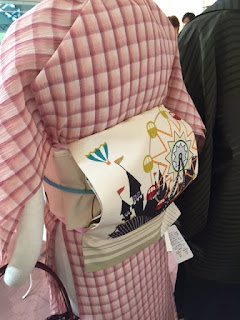Before the Heian Period, Kimono was simply a word to describe clothing and only those of high status wore anything ornate. During the Heian period, straight cut kimonos became commonplace as it made work on kimonos easier for the makers. With this style of cut the maker need not take in the wear's proportions to make the kimono. This way everyone could wear a kimono and at a decent price. Kimono then became commonplace to wear around town.
There are a variety of Kimono types and styles and the list is much too long to possibly name them all. That being said there are a few more interesting ones to point out.
Komon - this kimono has a simple pattern and is considered everyday wear.
Yukata - worn for summer festivals and not much else.
Furisode - worn by unmarried women as shown by the long sleeves to mark marital status.
We visited two kimono shops within the last week, one was rather fancy and up-scale, the other was humble and small (cute). Taylor felt rather uncomfortable going into the expensive shop as she felt she was being judged for just standing there. In the smaller one we felt much more comfortable walking around and looking through the merchandise. The yukatas we saw were mostly of the furisode style with the long sleeves to indicate that the women wearing them would be unmarried.
Cultural Appropriation is when a specific part of a culture is taken by someone not of that culture and worn or used in the likeness of a costume. When it comes to kimono, the safe thing to do would be to wait and be invited to wear it by the people of Japan, otherwise you get people who wear the kimono as a bathrobe, and disregard the cultural significance of the item. Cultural Appropriation has become a big discussion as of recent times as we see more and more culturally significant items and practices being taken and warped to suit others needs.
Cute.












No comments:
Post a Comment